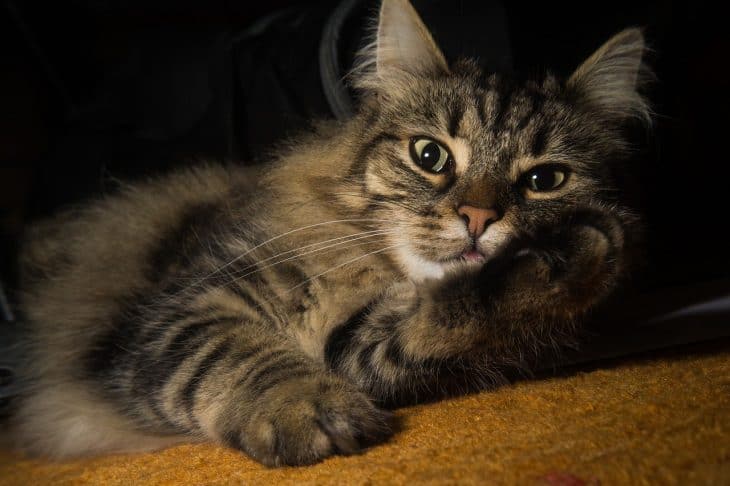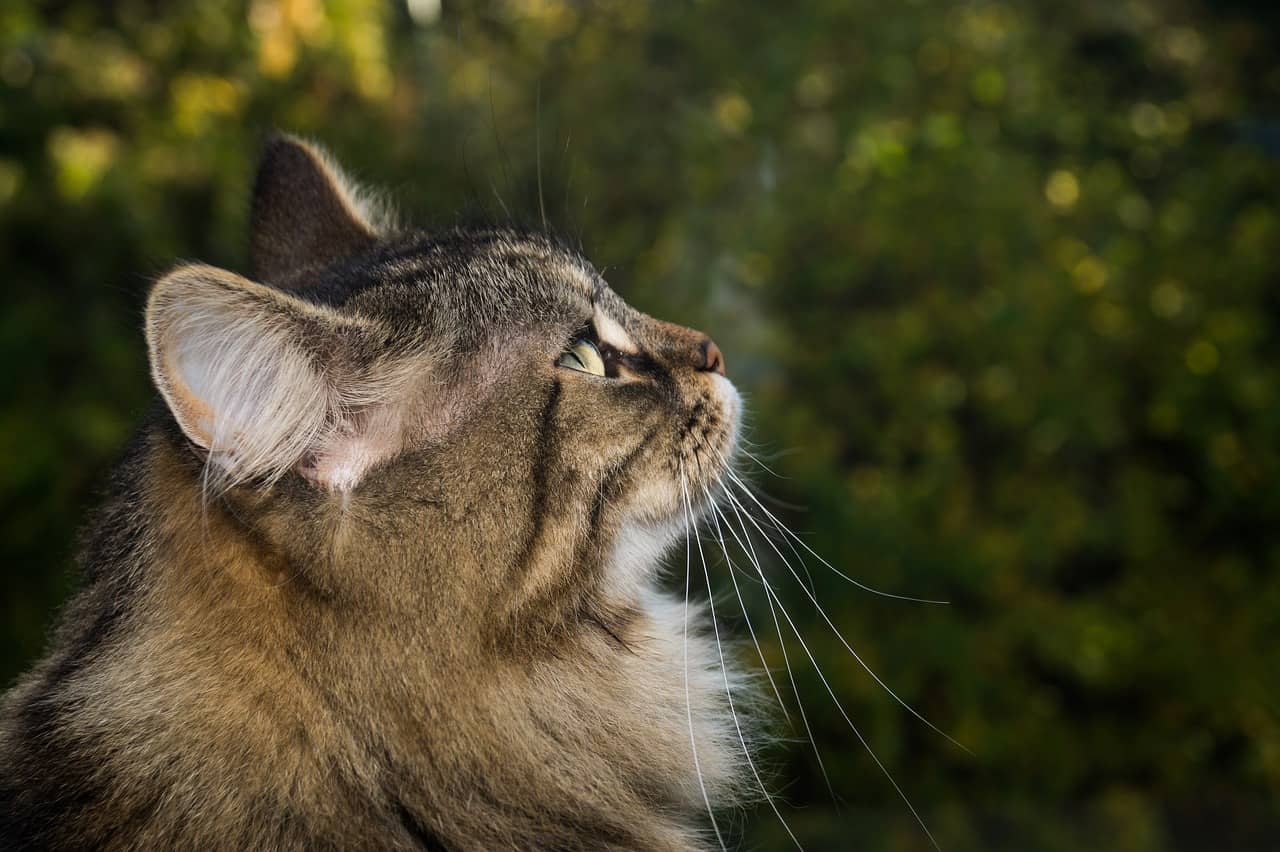
Throughout time, people have associated animals with folklore and mythology. In particular, the people of Scandinavia believed that the Norwegian Forest cat has close ties with the Norse goddess Freya. Originally living in mountaintops and forest floors, these felines have become one of the biggest domesticated cats in the world. However, there’s still a lot to learn about this cat aside from its expressive eyes and tufty coat. Find out more about this feline with these Norwegian Forest cat facts.
- Norwegian Forest cats have a lifespan of 14 up to 16 years.
- Around 1000 AD, the Vikings brought the Norwegian Forest cats to Norway.
- Male Norwegian Forest cats can weigh between 12lb to 20 lb (5kg to 9 kg).
- Female Norwegian Forest cats tend to weigh between 10 to 18 lb (4 to 8kg).
- It takes 5 years for them to fully grow.
- The Norwegian Forest cat is native to Northern Europe.
- The Norwegian Forest cat is a breed of a domestic cat.
- Its local name is Norsk skaukatt or Norsk skogkatt.
- The Norwegian Forest cat has adapted to cold climates.
- They are one of the most sociable cat breeds.
- Norwegian Forest cats can blends well with children and other animals, making them good family pets.
- They have long and glossy fur and a woolly undercoat which serves as their insulation.
- Scientists believe that the Norwegian Forest cats’ ancestors could be the landrace or short-haired cats.
- Apart from the Norwegian Forest cats, Vikings also brought the ancestors of the Siberian cat and Turkish Angora in Norway.
- The Norwegian Forests cats have evolved over the years into a big and thick-coated feline. Its most common colors are white, black, and brown.
- Even though they are social creatures, they don’t demand too much attention.
- Sailors and farmers valued the Norwegian Forest cat for its mouse hunting skills.
- They share many similarities with the Maine Coon.
- Norwegian Forest cats can scale trees easily with their strong claws.
- Heart and kidney diseases are their most common health problems.
FIFe acknowledged the Norwegian Forest cat breed in the late 70s.
In 1977, the Fédération Internationale Féline recognized the Norwegian Forest cat breed as an official cat breed. The Fédération Internationale Féline is an organization of cat registries with more than 40 members in different countries including Asia, Europe, and South America.
The Norwegian Forest cat is relatively new to the U.S.
Around 1979, the first breeding pair of Norwegian Forest cats came to the United States. Twelve years later, the Norwegian Forest cat was officially accepted by the Cat Fanciers’ Association (CFA). That said, the CFA is the biggest and most reputable pedigreed cat registering association in North America.
The Norwegian Forest cat has joined and won competitions.
After the Norwegian Forest cat got registered under the CFA, the breed started to join official competitions in 1993. Since then, the breed has won over 10 Grand Champions and Grand Premiers with some regional winners.
Norwegian Forest cats have mystical origins.
Known as skogkatt (forest cat) in Norway, people traditionally thought of them as fairy cats. Most of these mystic associations came from its ability to climb steep rocks that other cats could not handle. Some believed that Freya, the Norse goddess of love, beauty, and fertility especially loved these cats. According to mythology, the goddess always traveled in a chariot pulled by these felines.

The Norwegian forest cats almost went extinct.
During the 1930s and 1940s, Norwegian forest cats experienced a decline in its population. Back then, hybridization with the free-roaming domestic shorthairs in Norway was its major problem. Fortunately, the Norwegian Forest Cat Club started an official breeding program that prevented their extinction.
These cats are famous in Northern Europe.
Although Norwegian Forest cats aren’t one of the most popular cat breeds in the United States, they have a multitude of fans in Europe. In fact, Scandinavians love them so much that they affectionately call the cat wegies (short for Norwegians).
The Norwegian Forest cats have "snowshoes."
Compared to other breeds, the Norwegian Forest cat has relatively big and furry ears. Similarly, its feet are also extremely tufted. This extra fur acts as “snowshoes,” giving them added protection from the freezing ground.

The Norwegian Forest Cats are a slow-maturing breed.
Compared to other cats, the Norwegian Forest cat develops more slowly. However, strong boning occurs even in young kittens. Generally, Norwegian Forest cats continue to gain weight as they mature.
The Norwegian Forest cat has a triangular head shape.
Structurally, the Norwegian Forest cat’s head forms an equilateral triangle. Furthermore, its ears are equilateral from the base of its ears up to its chin, which is considerably lower compared to other cat breeds.
The Norwegian Forest Cats have flat foreheads.
The Norwegian Forest cats have flat foreheads and straight noses. When looking at them from the side, its nose or snout looks flatter compared to other felines. Similarly, its neck is generally very short with noticeable muscle.
It's not uncommon for them to descend from tree trunks face first.
Norwegian Forest cats have strong and sturdy bones on their legs. Heavily muscular, their hind legs are much longer than their the front legs. They also have thick, strong claws on all four feet. These traits make them excellent climbers as they navigate forest canopies.
They have almond-shaped eyes.
The Norwegian Forest Cat’s eyes are one of its most adorable features. Its big, expressive eyes usually range between different tones of emerald green to gold.

The Norwegian Forest cats are homebodies.
As a pet, the Norwegian Forest Cat enjoys the comforts of home, but it’s always a good idea to give them toys to keep them busy. As patient animals, they also don’t get stressed out very easily.
Norwegian Forest cats love to take long naps.
As with any feline, Norwegian Forest cats love to take long naps with periodic bouts of energetic activity in between. On average, they usually sleep for 12 to 16 hours per day.
Norwegian Forest cats shed often during the winter and spring.
For the Norwegian Forest cat, combing its coat with a slicker brush or steel comb at least once a week should be enough. However, it is very common for the Forest Cat to shed one coat in the spring and one in the winter. Due to this, you may want to scale up the combing to twice or even trice a week during this period.
Bathing Norwegian forest cats can be a challenge.
In contrast to its basic grooming, giving them a bath can be a challenge for inexperienced owners. Among the Norwegian Forest cat’s distinct features is a waterproof double coat, which has different properties compared to other breeds. Thus, it would be better to consult with a professional first if you plan to give your pet a bath.
They are one of the biggest breeds of domestic cats.
Even growing larger than some dog breeds, Norwegian Forest cats are way larger than your average domestic cat. To further illustrate, an average cat weighs only between 7 to 9 lbs, but a male Norwegian Forest cat can grow more than 20 lbs.
People in France love these cats.
In 2003, the Norwegian Forest cats became the fifth-most favorite cat breed in France. The rest of the popular cat breed in France includes the Sphynx, Ragdoll, Siberian, British Shorthair, and Maine Coon among others.
It's Norway's national cat.
In the 1950s, King Olaf V declared the Norwegian Forest cat as the country’s national cat. Today, the Forest Cat is one of the most popular pet choices not just in Norway but also in its neighboring countries such as Sweden, Finland, and Iceland.
Was this page helpful?
Our commitment to delivering trustworthy and engaging content is at the heart of what we do. Each fact on our site is contributed by real users like you, bringing a wealth of diverse insights and information. To ensure the highest standards of accuracy and reliability, our dedicated editors meticulously review each submission. This process guarantees that the facts we share are not only fascinating but also credible. Trust in our commitment to quality and authenticity as you explore and learn with us.
